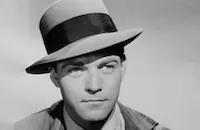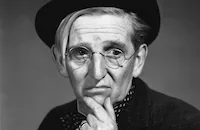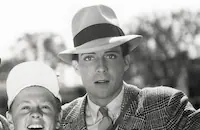Hitler's Madman

Brief Synopsis
Cast & Crew
Douglas Sirk
Patricia Morison
John Carradine
Alan Curtis
Howard Freeman
Ralph Morgan
Film Details
Technical Specs

Synopsis
Karel Vavra, a Czechoslovakian-born soldier with the English army, parachutes near his home village of Lidice and sneaks to the farm of Jan and Anna Hanka. From Anna, Karel, who has been in England since the start of the war, learns that his parents were sent to a German concentration camp because of his connections to the British. Unable to return home, Karel waits for Jan and Anna's daughter Jarmila, his sweetheart, in the same woods in which they played as children. Jarmila, a schoolteacher, is overjoyed to see Karel, who explains that he is on a mission to spread resistance among the Czech people. Although Jarmila worries about Karel's safety, Karel encourages her to have hope and courage. After Jarmila takes Karel to a cave to hide, Nepomuk, a reclusive hunter, finds them. Nepomuk at first threatens to turn Karel in, but then rounds up the village men for a secret meeting with Karel. Karel entreats the men, who include Jarmila's influential father and Janek, a miner, to fight the Nazis through sabotage, but Jan insists that only caution and patience are needed. Although Karel fails to persuade the men, Jarmila pledges her support to his cause. In town, meanwhile, the outspoken Anton Bartonek is arrested by the Gestapo, and his wife Maria pleads with Lidice's Nazi mayor, Herman Bauer, for help. Despite Bauer's hollow assurances, Anton's execution is ordered by the brutal Reich Protector Reinhard Heydrich, who oversees the Gestapo from Prague. Heydrich, who is known as "the hangman," then concludes that, in order to stem the tide of sabotage, he must stop Czechoslovakia's intellectuals. To that end, Heydrich orders all universities closed and rounds up a group of attractive women students, including Janek's daughter Clara, to serve as prostitutes for German soldiers. When Heydrich selects Clara as his personal mistress, she jumps to her death rather than serve him. Heydrich's actions spur some of Lidice's men to join with Karel, and the heartbroken Janek commits the first act of sabotage when he sets off an explosion in a mine, sacrificing himself in the process. Now doubting his neutral stance, Jan seeks counsel from Father Semlanik, who advises him to "suffer in silence." The next day, however, Father Semlanik is shot down by Heydrich when, during a prohibited religious festival, he protests the Nazi's sacrilegious behavior. Later, while Jan prays for guidance in Father Semlanik's church, Bauer's wife Marta, who has just learned that both of her sons have been killed in Russia, approaches him. Fed up with the senseless slaughter, Marta informs Jan that Heydrich will be driving through Lidice early the next morning, when her husband has ordered a curfew. Jan then finds Karel and Jarmila at the cave and plans Heydrich's assassination with them. The next morning, on the road between Lidice and another village, Jarmila, Karel and Jan ambush Heydrich's car, firing guns and hurling a grenade. Nepomuk, who had eavesdropped at the cave, then kills Heydrich's motorcycle escorts, giving his countrymen time to escape. Karel and Jarmila leave together, but Jan insists on returning to Lidice. The mortally wounded Heydrich is taken to Prague, where Gestapo officers order that hostages from Lidice be taken in order to rout out the assassins. Jan is among those seized, and afterward, the fleeing Karel and Jarmila are spotted by German soldiers and pursued. Although the patriots finally elude capture, Jarmila is shot and later dies in Karel's arms. In Prague, meanwhile, Gestapo chief Heinrich Himmler arrives in time to hear the dying Heydrich bitterly predict that Germany will be defeated. As revenge for the assassination, Himmler then orders that Lidice be exterminated. On the following Sunday, the women and children of Lidice are forced into concentration camp-bound trucks, while the men are lined up and shot. The village is then set on fire, but the spirits of the dead rise up and vow to fight on.

Director

Douglas Sirk
Cast

Patricia Morison

John Carradine

Alan Curtis

Howard Freeman

Ralph Morgan

Edgar Kennedy

Ludwig Stossel
Al Shean

Elizabeth Russell

Jimmy Conlin
Blanche Yurka
Jorja Rollins
Victor Kilian
Johanna Hofer
Wolfgang Zilzer

Tully Marshall
Richard Bailey

Richard Nichols
Betty Jean Nichols
Laura Lane
John Good
Emmett Lynn
Peter Van Eyck
Richard Ryen
Otto Reichow
Sigurd Tor
Ben Webster
Arthur Thalasso
Dan Duncan
Nellie Anderson
John Merton
Dick Talmadge
Frank Hagney
Hugh Maguire
Hans Von Morhart
Ray Miller
Charles Marsh
James Farley
Solvig Smith
Budd Buster
Chet Brandenburg
Ernst Hausman
Sam Waagenaar
Dan Fitzpatrick
Frank Todd
George Lynn
Wilmer Barnes
Carl Neubert

Dennis Moore
Lester Dorr
Edgar Licho
Fred Nurney
Lionel Royce

Hans Von Twardowski
Louis Arco
Michael Mark
Vicky Lane
Mary Elliott

Frances Rafferty
Natalie Draper

Ava Gardner
Walter Bonn

William Mccormick

Betty Jaynes
Celia Travers
Crew
Felix Bernstein
W. M. Dalgleish
Mel Delay
Jack Greenhalgh
Karl Hajos
Peretz Hirshbein
Albrecht Joseph
Rudolph Joseph
Ben Kamsler
Jack Kelly
Melvin Levy
Emil Ludwig
Bart Lytton
Doris Malloy
Seymour Nebenzal
Fred Preble
Eugene Schufftan
Ralph Slosser
Percy Townsend
Edward Willens

Videos
Movie Clip




Trailer
Film Details
Technical Specs

Articles
Hitler's Madman
Hitler's Madman is the story of determined Czech resistance fighters trying to free their country from Nazi occupation. During an assassination attempt they succeed in fatally wounding the region's governor, Reinhardt Heydrich (portrayed by John Carradine) who was also in actuality a key Nazi leader and architect of the Final Solution. As a result of his death SS Chief Heinrich Himmler orders the Czech town of Lidice destroyed with its men murdered and the women and children sent to concentration camps. (In real life, the Nazis even killed every dog they could find in the village.)
If nothing else, Hitler's Madman was an effective and timely reaction to the front page news headlines of its day. Heydrich's death occurred in June 1942 and the film was in theatres a year later. (Sirk claimed to have actually met Heydrich during a UFA party in the early 1930s.) There is also a key scene in the film that references a renowned American poet. Shortly after the notorious massacre in Lidice, the Writer's War Board asked Edna St. Vincent Millay for a poem about the incident. The resulting work - "The Murder of Lidice" - appeared as a radio broadcast heard across the country on NBC's network and was sent by short-wave to Europe.
Hitler's Madman was produced by the infamous "Poverty Row" studio PRC with some additional independent funding from Sirk and other German expatriates. One of the producers, for instance, was Seymour Nebenzal who in Germany had produced key works by Fritz Lang (M, 1931) and Georg Wilhelm Pabst (Pandora's Box, 1929) among others. The filming of Hitler's Madman took place in the summer of 1942 and lasted a week, the usual shooting schedule for a PRC film. Sirk used key German cinematographer Eugen Schufftan to shoot the film, but since Schufftan wasn't supposed to be working in the U.S. at that time B-Western vet Jack Greenhalgh (he had made 100 films during the preceding seven years!) got the credit. Another famous German who contributed, also uncredited, was director Edgar Ulmer (Detour, 1945) who worked on the script and the art design. Sirk didn't have a high opinion of Carradine as a film actor but thought he was perfect for the role of Heydrich, stating that Carradine's theatrical style (derived from his background in Shakespearean productions) captured the way real Nazis acted. Eagle-eyed viewers can also spot a nineteen-year-old Ava Gardner in one of her earliest film appearances.
When Hitler's Madman was finished, MGM mogul Louis Mayer saw it and liked it so much he bought it for his studio, making it one of the few, if not the first, outside films to be distributed by MGM. At Mayer's insistence, Sirk reshot material in October and November of 1942 though Sirk felt that this somewhat compromised the documentary nature of his film. Yet, despite the film's timely nature and Mayer's enthusiasm, Hitler's Madman sat on the MGM shelves until July of 1943 when it was finally released, though under a different title than planned. Originally it was called Hitler's Hangman because Heydrich had been nicknamed "Hangman Heydrich." However, Fritz Lang's film Hangmen Also Die, also about the Heydrich assassination, had already been released so the Sirk film was changed to Hitler's Madman to avoid confusion. (The 1976 film Operation Daybreak would also deal with the same events.)
Producer: Rudolf S. Joseph, Seymour Nebenzal
Director: Douglas Sirk
Screenplay: Peretz Hirschbein, Albrecht Joseph, Melvin Levy, Emil Ludwig, based on the novel Hangman's Village by Bart Lytton
Cinematography: Jack Greenhalgh, Eugen Schufftan (uncredited)
Editing: Dan Milner
Music: Karl Hajos, Eric Zeisl
Art Direction: Fred Preble, Edward Willens
Cast: John Carradine (Reinhardt Heydrich), Patricia Morison (Jarmilla Hanka), Alan Curtis (Karel Vavra), Ralph Morgan (Jan Hanka), Howard Freeman (Heinrich Himmler), Edgar Kennedy (Nepomuk), Elizabeth Russell (Maria Bartonek), Ludwig Stossel (Herman Bauer).
BW-85m. Closed captioning.
by Lang Thompson

Hitler's Madman
Quotes
Trivia
Notes
The working titles of this film were The Hangman and Hitler's Hangman. Variety reviewed the film as Hitler's Hangman. According to a Hollywood Reporter news item, when writers Emil Ludwig and Albrecht Joseph registered their unpublished story, which was based on another unpublished story by Bart Lytton, for copyright, it was titled "Victims Victorious." Hollywood Reporter also reported that, in June 1942, the MPAA banned the use of the title Hitler's Hangman, though the reason for the ban was not stated. The film opens with a verse from Edna St. Vincent Millay's poem "The Murder of Lidice," spoken by an offscreen narrator. Other lines from the poem are spoken during the film, and the poem's closing verse is heard at the end of the picture. Millay's poem was first heard in a radio broadcast on October 19, 1942 and was published the same year. Screen credits note that it was published by Harper & Brothers.
As depicted in the film, the Czech village of Lidice was destroyed on June 10, 1942, in retaliation for the assassination of Gestapo overlord Reinhard Heydrich. According to Hollywood Reporter, October 25, 1942 was declared Lidice Memorial Day in the U.S. and other United Nations countries. A Paramount Victory short, We Refuse to Die, which dramatized the Lidice massacre, was released on the same day, after a 12 October premiere in New York. (For more information about Heydrich and his assassination, for Hangmen Also Die!.) The Czech national anthem, "This Is Forever My Home," is sung in part in the film.
Hollywood Reporter news items add the following information about the production: Czech-born Francis Lederer was first considered for the role of "Heydrich," and Frances Farmer was considered for the role of "Jarmila." Helene Thimig was announced as a cast member, but did not appear in the completed picture. Half of the film's $300,000 budget was supplied by German refugee Irving D. Berttauer, and the other half was provided by Peter R. Van Duinen, the Bank of America and others. When production began, Angelus Pictures, an independent company headed by Seymour Nebenzal, had yet to secure a distributor. In October 1942, Republic Pictures optioned the picture, but in early February 1943, a month after the option had expired, M-G-M purchased a seven-year distribution lease on the film. Republic protested the lease, and an arbitration hearing between Republic and M-G-M was held in April 1943. The disposition of that hearing is not known, however.
When M-G-M took over as distributor, added scenes and retakes were ordered, and a new writer was brought in. Added material included Heydrich's deathbed scene with "Himmler" and university scenes featuring M-G-M starlets, including Ava Gardner. Mary McLeod and Leatrice Joy Gilbert were announced as cast members in the university scenes, but their appearance in the final film has not been confirmed. Sven Hugo Borg and Peter Michael were also cast in added scenes, but their appearance in the final film has not been confirmed. Hobart Cavanaugh and Nana Bryant are listed as cast members in early production charts, but their appearance in the final film is doubtful. According to the New York News review, the release of Hitler's Madman was delayed in New York because of competition from the above-mentioned United Artists film, Hangmen Also Die!, which opened nationally on March 26, 1943. According to an August 1942 article in PM (Journal), Vladimir Burban, a Czech minister in Washington at the time, would act as a technical advisor on the film, but the extent of his participation in the production has not been determined.















